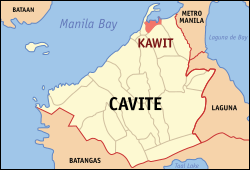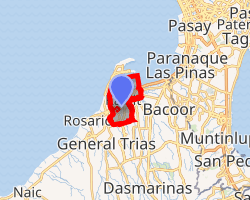Kawit, Cavite
Kawit, officially the Municipality of Kawit (Tagalog: Bayan ng Kawit), is a 1st class municipality in the province of Cavite, Philippines. According to the 2015 census, it has a population of 83,466.[3] It is one of the notable places that had a major role in the country's history during the 1800s and 1900s.
Kawit Cavite El Viejo | |
|---|---|
| Municipality of Kawit | |
 Seal | |
| Nickname(s): Site of the Declaration of Independence | |
| Motto(s): Alab ng Puso | |
 Map of Cavite with Kawit highlighted | |
OpenStreetMap 
| |
.svg.png) Kawit Location within the Philippines | |
| Coordinates: 14°26′N 120°54′E | |
| Country | |
| Region | Calabarzon (Region IV-A) |
| Province | Cavite |
| District | 1st District |
| Founded | 1898 |
| Barangays | 23 (see Barangays) |
| Government | |
| • Type | Sangguniang Bayan |
| • Mayor | Angelo Emilio G. Aguinaldo (NPC) |
| • Vice Mayor | Armando V. Bernal |
| • Congressman | Francis Gerald A. Abaya |
| • Electorate | 52,993 voters (2019) |
| Area | |
| • Total | 22.86 km2 (8.83 sq mi) |
| Population (2015 census)[3] | |
| • Total | 83,466 |
| • Density | 3,700/km2 (9,500/sq mi) |
| • Households | 19,510 |
| Demonym(s) | Kawiteño |
| Economy | |
| • Income class | 1st municipal income class |
| • Poverty incidence | 9.51% (2015)[4] |
| • Revenue (₱) | 182,706,348.70 (2016) |
| Time zone | UTC+8 (PST) |
| ZIP code | 4104 |
| PSGC | |
| IDD : area code | +63 (0)46 |
| Climate type | tropical monsoon climate |
| Native languages | Tagalog |
Formerly known as Cavite El Viejo, it is the location of his home,and the name Kawit is from the word kalawit, the Aguinaldo Shrine, where independence from Spain was declared on June 12, 1898. It is also the birthplace of Emilio Aguinaldo, the first President of the Philippines, who from 1895 to 1897, served as the municipality's chief executive.
Etymology
The name Kawit is derived from the Tagalog word kawit (hook) which is suggestive of its location at the base of a hookshaped shoreline along Manila Bay extending to the tip of Cavite City.
Legend, however, gives another version on how the town got its name. One day a Spanish visitor asked a native blacksmith about the name of the village. The latter was busy at the time pounding on the anvil a piece of hot metal that looked like a hook. He hesitated to speak, not understanding what the stranger was asking, but when pressed for an answer, and thinking that he wanted to know what he was doing, he merely said kawit (hook). The Spaniards left muttering the word kawit. In the course of the time the word kawit evolved into "cauite," and finally "cavite".
History
Kawit was the most thriving settlement prior to the coming of the Spaniards. In fact, the town provided the first anchorage of the Spaniards in the province, whence colonization and proselytization of the Christian religion began, spreading to all corners of the province.
For a long time, the place was called by the Spaniards "Cavite el Viejo" or Old Cavite to distinguish it from "Cavite la Punta" or "Cavite el Puerto," the commercial port and naval base (now Cavite City) whence came many Spanish marines on shore leave who made frequent visits to Cavite el Viejo, eventually turning it into a red-light district. This seedy reputation of the town was erased when Saint Mary Magdalene was made patroness, under the spiritual supervision of the Jesuits as ordered by Miguel García Serrano, O.S.A. (1618–1629), the fifth Archbishop of Manila.
With the establishment in the wake of the Philippine Revolution, the Philippine Independent Church built a shrine to Saint Michael, the Archangel in the barrio of Binakayan in 1902.
Cavite el Viejo was then a big town, comprising the municipality of Kawit today, Cavite la Punta (now Cavite City), Noveleta (called Tierra Alta by the Spaniards), and Imus. Eventually, these three barrios' populations grew and they eventually seceded to become independent municipalities.
Aside from its role as the birthplace of independence, Kawit was also the site of the Battle of Binakayan-Dalahican, one of several Filipino victories during the Revolution.
Barangays
Kawit is politically subdivided into 23 barangays. [2]
- Batong Dalig
- Balsahan-Bisita
- Binakayan-Aplaya
- Binakayan-Kanluran
- Congbalay-Legaspi
- Gahak
- Kaingen
- Magdalo (Putol)
- Manggahan-Lawin
- Marulas
- Pulvorista/Polvorista
- Panamitan
- Poblacion
- Samala-Marquez
- San Sebastian
- Santa Isabel
- Tabon 1
- Tabon 2
- Tabon 3
- Toclong (Different from Toclong in neighboring Imus)
- Tramo-Bantayan
- Wakas 1
- Wakas 2
Climate
| Climate data for Kawit, Cavite | |||||||||||||
|---|---|---|---|---|---|---|---|---|---|---|---|---|---|
| Month | Jan | Feb | Mar | Apr | May | Jun | Jul | Aug | Sep | Oct | Nov | Dec | Year |
| Average high °C (°F) | 29 (84) |
30 (86) |
32 (90) |
34 (93) |
32 (90) |
31 (88) |
29 (84) |
29 (84) |
29 (84) |
30 (86) |
30 (86) |
29 (84) |
30 (87) |
| Average low °C (°F) | 21 (70) |
20 (68) |
21 (70) |
22 (72) |
24 (75) |
25 (77) |
24 (75) |
24 (75) |
24 (75) |
23 (73) |
22 (72) |
21 (70) |
23 (73) |
| Average precipitation mm (inches) | 10 (0.4) |
10 (0.4) |
12 (0.5) |
27 (1.1) |
94 (3.7) |
153 (6.0) |
206 (8.1) |
190 (7.5) |
179 (7.0) |
120 (4.7) |
54 (2.1) |
39 (1.5) |
1,094 (43) |
| Average rainy days | 5.2 | 4.5 | 6.4 | 9.2 | 19.7 | 24.3 | 26.9 | 25.7 | 24.4 | 21.0 | 12.9 | 9.1 | 189.3 |
| Source: Meteoblue [5] | |||||||||||||
Demographics
| Year | Pop. | ±% p.a. |
|---|---|---|
| 1903 | 6,114 | — |
| 1918 | 6,855 | +0.77% |
| 1939 | 10,783 | +2.18% |
| 1948 | 13,970 | +2.92% |
| 1960 | 19,352 | +2.75% |
| 1970 | 28,447 | +3.92% |
| 1975 | 33,813 | +3.53% |
| 1980 | 39,368 | +3.09% |
| 1990 | 47,755 | +1.95% |
| 1995 | 56,993 | +3.37% |
| 2000 | 62,751 | +2.08% |
| 2007 | 76,405 | +2.75% |
| 2015 | 83,466 | +1.11% |
| Source: Philippine Statistics Authority[3][6][7][8] | ||
In the 2015 census, the population of Kawit was 83,466 people,[3] with a density of 3,700 inhabitants per square kilometre or 9,600 inhabitants per square mile.
Culture
Maytinis Festival
An original Kawit tradition that takes place every Christmas Eve, a dramatic retelling of the Virgin Mary and Joseph's search in bethlehem for a place to stay called "Panunuluyan". This reenactment happens on the streets of Kawit with different floats depicting different biblical scenes from Adam and Eve up to Mary and Joseph. The "Panunuluyan" takes place in several houses and is done in singing until it reaches the 400-year-old St. Mary Magdalene Church of Kawit where the Virgin Mary and Joseph are welcomed by angels in a giant "belen" (Nativity Scene) which covers the whole main Retablo or altarpiece of the church. The songs performed by the angels acted by little girls are mostly in Spanish and Tagalog.
Government
Like any other Philippine municipality, Kawit is headed by a municipal mayor, vice mayor, and ten councilors, eight of them elected at large by the voting populace and two of them being sectoral representatives (one for the barangays and one for the youth, elected respectively through their federations).
The current mayor of the historical town is Angelo Emilio G. Aguinaldo who succeeded his father, Reynaldo "Tik" Aguinaldo, after winning over former Vice Mayor Paul Plaridel A. Abaya Jr. by a historic margin of 5,039 votes in the last May 2016 elections.
Mayor Angelo Aguinaldo served as a Sangguniang Bayan member from 2013–2016.
Then Mayor Reynaldo "Tik" Aguinaldo was elevated to the mayorship after three terms as vice mayor. The scion of the first Philippine president has twice (2007 and 2010) beaten Federico "Hit" Poblete, another descendant of Emilio Aguinaldo (youngest son of Maria Aguinaldo y Poblete: one of General Emilio Aguinaldo's daughters), Poblete served a total of five terms as its chief executive. He used to be an undersecretary for the Department of Agrarian Reform under the Estrada administration after his first three terms as mayor (1988–1998).
Sister city

See also
- Aguinaldo Shrine
- St.Michael the Archangel Parish of Binakayan (Aglipayan Church)
- St. Mary Magdalene Church of Kawit
- Baldomero Aguinaldo Shrine
- Battle of Binakayan-Dalahican
Images
- St. Mary Magdalene Church of Kawit
- Procession (Karakol, dancing)
- Aguinaldo tomb
- Old Town Hall facade
- Junction
References
- "Municipality". Quezon City, Philippines: Department of the Interior and Local Government. Retrieved 31 May 2013.
- "Province: Cavite". PSGC Interactive. Quezon City, Philippines: Philippine Statistics Authority. Retrieved 12 November 2016.
- Census of Population (2015). "Region IV-A (Calabarzon)". Total Population by Province, City, Municipality and Barangay. PSA. Retrieved 20 June 2016.
- "PSA releases the 2015 Municipal and City Level Poverty Estimates". Quezon City, Philippines. Retrieved 1 January 2020.
- "Kawit: Average Temperatures and Rainfall". Meteoblue. Retrieved 12 May 2020.
- Census of Population and Housing (2010). "Region IV-A (Calabarzon)". Total Population by Province, City, Municipality and Barangay. NSO. Retrieved 29 June 2016.
- Censuses of Population (1903–2007). "Region IV-A (Calabarzon)". Table 1. Population Enumerated in Various Censuses by Province/Highly Urbanized City: 1903 to 2007. NSO.
- "Province of Cavite". Municipality Population Data. Local Water Utilities Administration Research Division. Retrieved 17 December 2016.
- "List of Sister City Affiliations with Japan (by country)". Clair Singapore.
External links
| Wikimedia Commons has media related to Kawit, Cavite. |